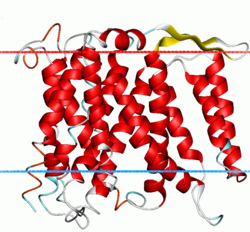Biology:NhaA family
| Na+/H+ antiporter 1 | |||||||||||
|---|---|---|---|---|---|---|---|---|---|---|---|
 | |||||||||||
| Identifiers | |||||||||||
| Symbol | Na_H_antiport_1 | ||||||||||
| Pfam | PF06965 | ||||||||||
| InterPro | IPR004670 | ||||||||||
| TCDB | 2.A.36 | ||||||||||
| OPM superfamily | 106 | ||||||||||
| OPM protein | 1zcd | ||||||||||
| |||||||||||
Na+/H+ antiporter A (NhaA) family (TC# 2.A.33) contains a number of bacterial sodium-proton antiporter (SPAP) proteins. These are integral membrane proteins that catalyse the exchange of H+ for Na+ in a manner that is highly pH dependent. Homologues have been sequenced from a number of bacteria and archaea. Prokaryotes possess multiple paralogues. A representative list of the proteins that belong to the NhaA family can be found in the Transporter Classification Database.
Structure
Proteins of the NhaA family are of 300-700 amino acyl residues in length. NhaA of E. coli is a homeodimer, each subunit consisting of a bundle of 12 tilted transmembrane α-helices (TMSs).[1][2][3][4][5]
Molecular dynamics simulations of NhaA enabled proposal of an atomically detailed model of antiporter function.[6] Three conserved aspartate residues are key to this proposed mechanism: Asp164 (D164) is the Na+-binding site, D163 controls the alternating accessibility of this binding site to the cytoplasm or periplasm, and D133 is crucial for pH regulation.[6][7][8]
Function
Na+-H+ antiporters are integral membrane proteins that exchange Na+ for H+ across the cytoplasmic membrane and many intracellular membranes. They are essential for Na+, pH, and volume homeostasis, which are processes crucial for cell viability.[8][9] The E. coli protein probably functions in the regulation of the internal pH when the external pH is alkaline, and the protein effectively functions as a pH sensor.[7] It also uses the H+ gradient to expel Na+ from the cell. Its activity is highly pH dependent.[3][10]
The generalized transport reaction catalyzed by NhaA is:[6][11]
Na+ (in) + 2H+ (out) ⇌ Na+ (out) + 2H+ (in).
See also
- Sodium-Proton antiporter
- Antiporter
- Transporter Classification Database
References
- ↑ "Projection structure of NhaA, a secondary transporter from Escherichia coli, at 4.0 A resolution". The EMBO Journal 18 (13): 3558–63. July 1999. doi:10.1093/emboj/18.13.3558. PMID 10393172.
- ↑ "Three-dimensional structure of the ion-coupled transport protein NhaA". Nature 403 (6765): 112–5. January 2000. doi:10.1038/47534. PMID 10638764. Bibcode: 2000Natur.403..112W.
- ↑ 3.0 3.1 "Structure of a Na+/H+ antiporter and insights into mechanism of action and regulation by pH". Nature 435 (7046): 1197–202. June 2005. doi:10.1038/nature03692. PMID 15988517. Bibcode: 2005Natur.435.1197H.
- ↑ "Multiconformation continuum electrostatics analysis of the NhaA Na+/H+ antiporter of Escherichia coli with functional implications". Proceedings of the National Academy of Sciences of the United States of America 103 (8): 2629–34. February 2006. doi:10.1073/pnas.0510914103. PMID 16477015. Bibcode: 2006PNAS..103.2629O.
- ↑ "Crucial steps in the structure determination of the Na+/H+ antiporter NhaA in its native conformation". Journal of Molecular Biology 362 (2): 192–202. September 2006. doi:10.1016/j.jmb.2006.07.019. PMID 16919297.
- ↑ 6.0 6.1 6.2 "Mechanism of Na+/H+ antiporting". Science 317 (5839): 799–803. August 2007. doi:10.1126/science.1142824. PMID 17690293. Bibcode: 2007Sci...317..799A.
- ↑ 7.0 7.1 "Histidine-226 is part of the pH sensor of NhaA, a Na+/H+ antiporter in Escherichia coli". Proceedings of the National Academy of Sciences of the United States of America 90 (4): 1212–6. February 1993. doi:10.1073/pnas.90.4.1212. PMID 8381959. Bibcode: 1993PNAS...90.1212G.
- ↑ 8.0 8.1 "The enlightening encounter between structure and function in the NhaA Na+-H+ antiporter". Trends in Biochemical Sciences 33 (9): 435–43. September 2008. doi:10.1016/j.tibs.2008.06.007. PMID 18707888.
- ↑ "Cloning, functional expression and primary characterization of Vibrio parahaemolyticus K+/H+ antiporter genes in Escherichia coli". Molecular Microbiology 59 (2): 651–63. January 2006. doi:10.1111/j.1365-2958.2005.04966.x. PMID 16390457.
- ↑ "Helix VIII of NhaA Na(+)/H(+) antiporter participates in the periplasmic cation passage and pH regulation of the antiporter". Journal of Molecular Biology 413 (3): 604–14. October 2011. doi:10.1016/j.jmb.2011.08.046. PMID 21907722.
- ↑ "2.A.33 The NhaA Na+:H+Antiporter (NhaA) Family". http://www.tcdb.org/search/result.php?tc=2.A.33.
Further reading
- "Conformations of NhaA, the Na/H exchanger from Escherichia coli, in the pH-activated and ion-translocating states". Journal of Molecular Biology 386 (2): 351–65. February 2009. doi:10.1016/j.jmb.2008.12.042. PMID 19135453.
- "Transmembrane segment II of NhaA Na+/H+ antiporter lines the cation passage, and Asp65 is critical for pH activation of the antiporter". The Journal of Biological Chemistry 285 (3): 2211–20. January 2010. doi:10.1074/jbc.M109.047134. PMID 19923224.
- "Sequencing of the gene ant which affects the Na+/H+ antiporter activity in Escherichia coli". The Journal of Biological Chemistry 263 (21): 10408–14. July 1988. doi:10.1016/S0021-9258(19)81531-4. PMID 2839489.
- "Na(+)/H(+) antiporters". Biochimica et Biophysica Acta 1505 (1): 144–57. May 2001. doi:10.1016/s0005-2728(00)00284-x. PMID 11248196.
- "NhaA antiporter functions using 10 helices, and an additional 2 contribute to assembly/stability". Proceedings of the National Academy of Sciences of the United States of America 112 (41): E5575-82. October 2015. doi:10.1073/pnas.1510964112. PMID 26417087. Bibcode: 2015PNAS..112E5575P.
- "A model-structure of a periplasm-facing state of the NhaA antiporter suggests the molecular underpinnings of pH-induced conformational changes". The Journal of Biological Chemistry 287 (22): 18249–61. May 2012. doi:10.1074/jbc.M111.336446. PMID 22431724.
As of this edit, this article uses content from "2.A.33 The NhaA Na+:H+Antiporter (NhaA) Family", which is licensed in a way that permits reuse under the Creative Commons Attribution-ShareAlike 3.0 Unported License, but not under the GFDL. All relevant terms must be followed.
 |

